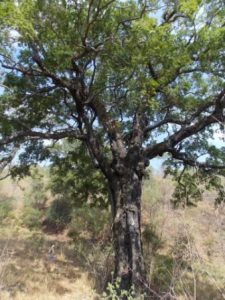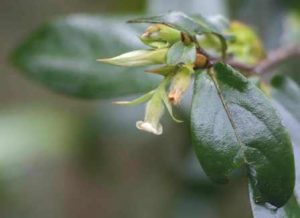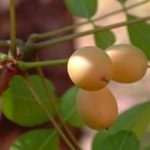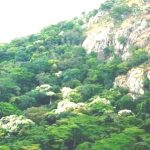TREE LIFE
JULY 1981
MASHONALAND CALENDAR
Saturday July 4th : Botanic garden walk. Meet in the car park at 1030 hours. Please note the changed time.
Sunday July 19th : Wedza Mountain. Bus leaves Monomatapa Car Park at 0800 hours. (I realise that this is horribly early particularly during winter but we have a long way to go). There will be a Security guard at Monomatapa Car Park. Fare $5.50.
Directions : Take the Marandellas road. Just after Grasslands Research Station turn right into the Watershed road for 2.5km and then turn left on to the Bridge Road (sign post says Wedza 38miles). At the T-junction with Gloucester Road (after 47km) turn left. Wedza Village is 14km from there – drive straight through for 15km to Garabu Store, take the left hand fork and follow the Tree Society signs.
Saturday/Sunday 19th and 20th September : Umtali. Arrangements are well in hand for a super weekend and I hope that I shall be able to announce full details in the next Newsletter. Fare $15. Please make your own arrangements for accommodation – either at an hotel or with friends.
BOTANIC GARDEN WALK, SATURDAY JUNE 6TH
An account of our stroll by Cheryl Haxen. This was a dash about the Diospyroses!! What we expected to be a quiet amble between two or three species, turned out to be a brisk zigzagging from one end of the gardens to the other, as Tom Muller continued to recall every more species, and as the Diospyros mespiliformis occurs at lower altitudes, typical genus Diospyros contains species adapted to a range of conditions we found ourselves moving from ‘Lowveld riverine’ to ‘Highveld savanna’ to ‘Montane forest’.

Diospyros mespiliformis . Bart Wursten.
Source: Flora of Zimbabwe
Diospyros mespiliformis occurs at lower altitudes, typically on river banks. At medium altitudes, however, it is usually found on termite mounds. The wood is hard and dark – the diospyroses are members of the ebony family, Ebenaceae – and the fruits are edible.
Diospyros senensis is a riverine species, with leaves similar in shape to those of D. lycioides, though somewhat larger. It is typically a multi-trunked tree, the stems being covered with distinctive lateral spurs.
Diospyros lycioides is the one most commonly on our outings. However, there are two subspecies, lycioides and sericea, the latter being the more common, which is distinguished by the relative hairiness of the leaves.
Diospyros usambarensis is a tree of the S.E. Lowveld, while Diospyros squarrosa occurs both in the S.E. and in the Zambezi valley.
Diospyros abyssinica and Diospyros ferrea are both forest species. Diospyros abyssinica is a forest canopy tree, reaching 50m or more under favourable conditions. It bears shiny leaves with drip-tips and occurs in the Mount Selinda and Bunga forests, where, so Tom tells, it can be identified by its rough bark (it being the only tree species in the area with such bark).

Diospyros whyteana. Photo: Bart Wursten. Source: Flora of Zimbabwe
Diospyros ferrea is rare, and is a species of the drier forest. It occurs in the Bunga forest where, we were told it does not appear to be regenerating as specimens found there are large mature trees.
Lastly we found Diospyros whyteana which has a fairly limited distribution in this country but occurs throughout Transvaal and Natal, right through to the Cape. Its pale shiny leaf fringed with whitish hairs make it unmistakable particularly when it is also in fruit, the fruit is completely enclosed in the expanded and fused sepals giving it a gooseberry look, and give it its common name of “bladder nut”.
-Cheryl Haxen
SPELONKEN 21ST JUNE
Having made the arrangements to visit Spelonken I discovered that the Society had been there twice before and became rather worried about the success of the visit. However, thanks to the warm welcome and hospitality afforded by Hal and Marge Burows and the incredible variety of trees which grow there my fears proved to be groundless and we spent an interesting and lovely day.
The bus dropped us at the gate and we gradually made our way along between the base of the kopje and the road until we reached the homestead some two or more hours later.
Our wandering was enhanced by finding the unexpected, the uncommon and the unusually large, and to add to the beauty of the day we had the pleasure of a constant view of the blue expanse of the Mazowe Dam and close at hand the red of Aloe chaubaudii in flower and Aloe excelsa in bud. Our first discussion centred around Uapaca nitida, the narrow-leaved mabobohobo (or muzhanje) with its very long petioles and galls on the leaves and stem which resembled fruit. Apparently this is quite common and the galls eventually turn black. We then braved the long grass of a gully to admire Diospyros mespiliformis, the Ebony Diospyros, in green fruit all set about with Friesodielsia obovate, the Dwala Berry. From the gully we went on to what we eventually decided was the long tailed Cassia, Cassia abbreviata, lounging on the edge of a dwala. The highlight for the unusual must go to Boscia angustifolia with its hard little narrow leathery leaves tipped with a sharp spine. Angustifolia means “narrow leaves” from the Latin angustus narrow and folium, a leaf. These trees often grow on termite mounds and although there was no evidence of one we were assured that there had been one there. Another tree of interest was Ficus glumosa (F. sonderi), the Mountain Rock Fig, sploshing itself against the rocks. There was some discussion as to whether the leaves and branchlets were hairy enough but we decided that the books usually say hairy at first but losing these at maturity and so as it was the end of the growing season maybe the hairs had been lost. Both Pericopsis angolensis, the Muwanga or Afrormosia, and Swartzia madagascariensis, the snake bean tree, have compound leaves which are imparipinnate with sub-opposite to alternate leaflets and we were able to see that those of Pericopsis tended to be more alternate and those of Swartzia more sub-opposite. It was also pointed out that Pericopsis has little thread-like stipels (if this were a leaf and not a leaflet they would be called stipules) a feature I shall certainly look for in future. And of course, the bark and habit of the two are very different. While Pericopsis has a pale smooth bark and is inclined to be slim and graceful, Swartzia is squat with a rounded crown and a dark rough bark. Allophylus africana and Pleurostylia africana reached up to the sky so that only those with binoculars were able to identify and admire them. There is no doubt that along the edge of granite there are areas of underground water accumulation which results in very large trees. This theory was also borne out by the unexpected presence of the woodland Water berry, Syzygium quineense.
After an early lunch teams were selected for a competition to see who could identify the greatest number of species in the vegetation occurring in a predetermined area. I used the word vegetation intentionally as Hal had been round and identified everything, even those brave little 2-leaved things which given ideal conditions could ultimately become trees. The teams must have smelt the delicious tea laid on by Marge Burrows and were lured back to the homestead after about 1.5 hours. The team which resisted temptation came home last was the winner and were given a pocket of oranges by Hal Burrows as a reward for their efforts. We enjoyed having some members from the Ayrshire branch and also Brian Best on his first outing since leaving Matabeleland. Finally once again, to Marge and Hal thank you for the welcome, the tea and gorgeous spread and the oranges but most of all thank you for sharing your trees with us.
-Meg Coates Palgrave
WEDZA MOUNTAIN
Our July outing will be to the Wedza Mountain; the last visit by the Society was 10 years ago and as this is an area of great interest we thought everyone would like to know a bit more about it, even those who will not be able to join us on the trip. The Wedza Mountains are situated 60km south of Marandellas and 60km west of Inyazura and are approximately 11km south south east of Wedza village (23km by road). The range lies with its long axis in a NE-SW direction, has a length of about 21km and is 5km wide at its widest.
Much of the mother rock is serpentine capped with banded ironstone which, being very hard, explains why over the past 300 million years the massive rock has remained behind whilst the surrounding countryside has eroded away. The mountains are divided into three separate physical entities. The northern area, Dowa reaches an altitude of 4600 ft, and is separated from the central area Romorehoto, by the Nyamidzi River which then runs down the valley to the east of the mountains into (believe it or not) the Sabi River of which it is, at this stage a major tributary. The Sabi flows round the southern end of the southern section known as Gandamasunga, which rises about 1300 ft.above the general level of the countryside and is separated from the central mountain by the Gandamasunga Gap. It is in the area near the Gap that the old Adzwe gold mine was situated which was founded on extensive ancient workings for the Gold Fields Rhodesian Development Company Limited and worked between 1925 and 1939. The central section known as Romorehoto is the highest area rising about 1475 ft above the land on either side and about 2100ft above the Sabi River. Here the mountain is 5km wide and has 2 peaks Romorehoto (altitude 5775ft) which is joined by a saddle to the highest point Dangamvuri (altitude 5875 ft) on which there was a police radio post during the war. On the eastern side below the saddle is an old sheelite mine.
The dominant vegetation is Brachystegia type woodland; B. boehmii on the gentle middle and lower slopes; B. glaucescens on the steeper slopes and B. spiciformis which are, like those at Inyanga, rather stunted and covered in old man’s beard, usually occurring where there are mists.
The most interesting trees that occur here are those that are also found in the eastern district forests, were growing mainly along streams and in gullies where there is plenty of moisture. Although there is a normal summer rainfall of about 38”(965mm) at Wedza itself there are no records for the mountain. However, a lot of extra precipitation must occur because they stand so much higher than the surrounding land, and during the winter there are often days of “guti” over the mountains and this has undoubtedly enabled the eastern district forest type vegetation to survive. Perhaps even a reminder of a past age when the climate was colder and wetter and evergreen forests connected this area to the eastern district highlands.
We did a brief trip on one of those “guti” days and stopped at the Stream, at the bottom of the central section, on which the little Nyamatanora Dam is situated. Ferns and moss and fascinating fungi abounded and in the short time we were there we found Bridelia micrantha, Mitzeeri and Rhus natalensis, the Natal Rhus which I have not collected before, in addition to several other forest species including Diospyros whyteana, the Bladder nut.
THE NICKEL ANOMALY ON WEDZA MOUNTAIN
An area such as this, where vegetation differs markedly from surrounding associations is known as an anomaly. Nickel is thought to be the heavy metal most toxic to plant growth, followed by copper. Moreover, the effects of this toxicity are manifested in the vegetation in different ways on copper and on nickel soils. Professor Wild of the University’s Botany Department has recorded a total of 436 species occurring in copper soils throughout Rhodesia and only 302 on nickel soils.
Numbers on each particular anomaly are, of course, far less. On the very strong one near the old Wedza Mine, for example, a total of only 17 species of grasses, herbs and trees has been found.
Thus, a very reduced number of species can immediately indicate the presence of heavy metal in the soil. The species themselves give a further indication. On the Wedza anomaly, in an area surrounded by a common musasa/mufuti woodland, the dominant tree is stunted Combretum molle.
Suspicions are further confirmed by the presence of the soft, woolly herb Dicoma macrocephala in numbers on the area, since a form or perhaps a subspecies of this plant seems to be found only on nickel soils in Rhodesia. The plant has earned the name of “Nickel flower”.
This and other plants have the ability to take up nickel which is of no use to them, and remain unaffected. The analysis of the leaves of such plants for heavy metals forms the basis for “Biogeochemical” prospecting. This method is presently being employed using vegetation growing on the wind blown Kalahari sands to determine whether the under lying rocks contain economic minerals.
On this trip we will only be able to examine a tiny part of these huge mountains that vary so much in all their aspect. Perhaps this should be the beginning of a series of visits. There is a move to have the Wedza Mountains declared a Nature Reserve and if this happens it could become more accessible which would certainly make future trips easier.
In producing these notes I must acknowledge the information gleaned from::“
The Geology of the Country South and East of Wedza” by P. Fey, M.Sc. Geological Survey Bulletin No 77; “A visit to the Wedza Mountain” by J.N.Talbot and “Conservation Plan, Wedza Mountain”, a report to Natural Resources Department by Thomas Muller.
-Meg Coates Palgrave
ZIMBABWE SCIENCE NEWS VOL. 15, NO. 5. MAY 1981
The two main themes of this issue are the effect of large river dams on ecology with the Mupata Gorge scheme particularly in mind and the civil engineering and financial discussion on the question ”Can Zimbabwe have a port?”
Indigenous trees by Trevor Gordon – species presented Albizia adianthifolia
MATABELELND CALENDAR
Sunday July 5th : Hillside Dams (Rough area) meet at Upper Dam Wall at 0830 hours.
Sunday September 13th : Matopos National Park. Meet at Retreat Shopping Centre at 0830 hours.
LEARNER GROUP
I have recently had the pleasure of joining Mrs. Gill Masterson and her learner group and have thoroughly enjoyed looking at a few trees in great detail. If anyone would care to join one of these outings which are usually held on a Saturday morning by arrangement you would be very welcome; please get in touch with either Gill or myself.
Meg Coates Palgrave – Chairman



